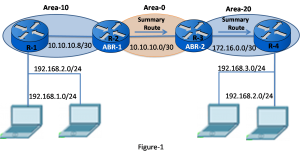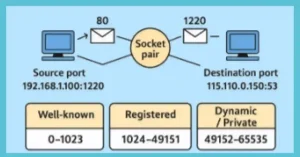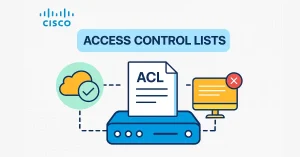The majority of the command for multiarea OSPF verification is the same as the command we already used in the verification of single area OSPF. The command, “show ip ospf neighbor”, “show ip ospf” and show ip ospf interface are the same command. The following command specifically includes the information of multiarea OSPF.
- show ip protocols
- show ip ospf interface brief
- show ip route ospf
- show ip ospf database
The command can also be used for OSPFv3, simply substitute ip with ipv6. In this article, we will use the same topology of OSPF, which we have used in the previous article. Figure 1 illustrates the OSPF topology.

Verify General Multiarea OSPF Settings
We can verify the general multiarea OSPF setting using the “show ip protocols” command. The output of the command displays the configured routing protocols on a router including router ID, several areas in the router, and networks included within the routing protocol configuration. Figure 2 illustrates the OSPF settings of R2. Notice that the command shows that there are two areas. The Routing for Networks segment identifies the networks and their particular areas.

We can also use the “show ip ospf interface brief” command to show brief OSPF-related information of OSPF-enabled interfaces. This command provides helpful information, such as the OSPF process ID, the area that the interfaces are in, and the cost of the interface.
Verify the OSPF Routes
The “show ip route” is the most common command to verify a multiarea OSPF configuration. We can add the “ospf” parameter to display only OSPF-related information.

Figure 3 displays the routing table of R2. See the O IA entries in the routing table, which illustrates networks learned from other areas. O specifically represents OSPF routes, and IA represents interarea routes, meaning that the route is originated from another area.
The [110/2], [110/3] entry in the routing table illustrates the administrative distance and cost of the route. The administrative distance is (110) and the total cost of the routes (cost of 2 or 3).
Verify the Multiarea OSPF LSDB
To examine the contents of the LSDB we can use “show ip ospf database” command. Several options are available with this command. Figure 4 illustrates the content of the LSDB of R2.

Notice R2 has database entries for area 0 and area 10, so ABRs must maintain a separate LSDB for each area to which they belong. In the output, Router Link States identifies the number of routes for each area. The Summary Net Link States for identifies networks learned from other areas and which neighbour advertised the network for both areas.
Verify Multiarea OSPFv3
We can verify the OSPFv3 with similar verification commands with only substitute ip with ipv6. We can use all the commands discussed for OSPFv2 verification.




